Vancouver B.C. - Rare Element Resources Ltd. (TSX-V: RES and AMEX: REE) is pleased to report a summary of results from its 2010 rare earth element (REE) exploration program and an outline of plans for the 2011 program at the Bear Lodge property in northeastern Wyoming, USA.
Vancouver B.C. - Rare Element Resources Ltd. (TSX-V: RES and AMEX: REE) is pleased to report a summary of results from its 2010 rare earth element (REE) exploration program and an outline of plans for the 2011 program at the Bear Lodge property in northeastern Wyoming, USA (Figure 1). The 2010 REE exploration program included a total of 42,409 feet of core in 63 drill holes for resource definition and exploration purposes, and 3,844 feet of large diameter core for bulk sample material dedicated to a pilot plant test scheduled for the third quarter of 2011. The REE drilling program was augmented by geological mapping, geophysical surveys, soil and rock chip geochemical surveys, and additional bulk sampling of near-surface mineralized material.
Rare Element's independent resource estimation consultant is currently compiling the 2010 drilling results, and the updated resource estimate should be reported during the second quarter of 2011. The Company expects that the overall resource will increase in size, and that a substantial portion of the oxide resource will be upgraded to the "indicated" and, possibly, "measured" categories. Rare Element Resources' exploration and evaluation plans for the Bear Lodge project in 2011 include:
-
Additional resource definition drilling to expand and upgrade the resources at the Bull Hill SW and Bull Hill NW deposits
-
Exploration and resource definition drilling at the Whitetail Ridge prospect.
-
Exploration drilling at the Bull Hill West, Carbon South, and other prospective REE targets identified during the 2010 exploration program.
-
Geological mapping, geochemical sampling, and geophysical surveys over selected areas in order to better delineate current target areas and identify new targets for economic REE mineralization.
-
Collection of additional bulk sample mineralized material for the pilot plant testing from a second large diameter core drilling program in select, well-mineralized areas, along with additional sampling of mineralized surface exposures in road cuts, trenches, and drill sites.
-
A condemnation drilling program to ensure that the proposed low-grade stockpile and waste facility will not cover ground that is prospective for REE and/or gold mineralization.
-
Environmental baseline and geotechnical studies directed toward ultimate mine development.
-
Continued metallurgical testing of oxide zone mineralized material for optimization of mineral concentration and chemical concentration processes.
-
Pilot plant metallurgical testing on bulk sample material collected in 2010 to produce a potentially saleable rare earth carbonate concentrate.
-
Continuation of metallurgical testing on the transitional mineralized material.
-
Completion of a Preliminary Feasibility Study by the end of the fourth quarter of 2011.
Jim Clark, Vice President of Exploration states: "The 2010 exploration and drilling program was tremendously successful, and the Company expects this success to propagate into 2011. In addition to expanding the resources and upgrading the resource category, our work in 2010 identified new prospective areas and improved tremendously our understanding of the deposit. Our developing deposit model should enhance our exploration and resource definition work in 2011. The Company is excited about the follow-up drilling on the Whitetail Ridge target, which could increase significantly the global deposit resource. We anticipate the achievement of several key milestones during 2011 on the road to production, including the pilot plant test work and a preliminary feasibility study. Our exploration team is gearing up for a great year!"
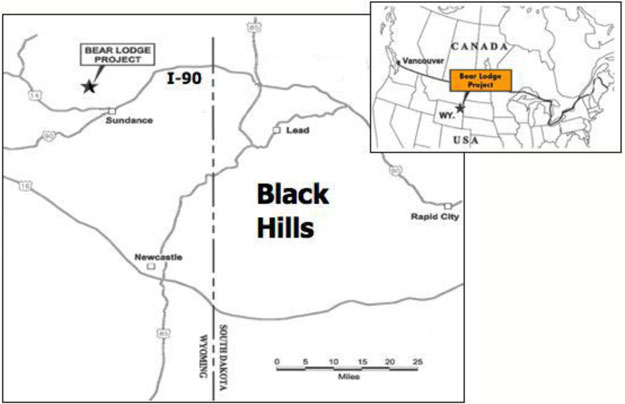
Figure 1. Location of the Bear Lodge project in northeastern Wyoming, near the town of Sundance.
Results from the 2010 REE Resource Definition and Exploration Drill Program
Details of the resource definition and exploration drilling programs were reported previously in news releases dated 15 September 2010, 9 November 2010, 10 January 2011, 7 February 2011, and 6 April 2011. Details of the bulk sample drilling were reported in a news release dated 12 October 2010. The objectives of the 2010 REE drill program were: 1) to upgrade a significant part of the resource from inferred to measured and indicated; 2) expand current resources at the Bull Hill Southwest and Bull Hill Northwest areas; 3) conduct initial drill exploration at the Whitetail Ridge target area; and 4) identify other prospective areas for potentially economic REE mineralization. An NI 43-101-compliant, inferred resource estimate for the Bull Hill SW and Bull Hill NW resource areas, based on drilling by the Company through 2009, was completed in May 2010 and reported in a news release dated 26 May 2010. Locations of the holes drilled during the Company's 2010 REE exploration and resource definition program are shown in Figure 2.
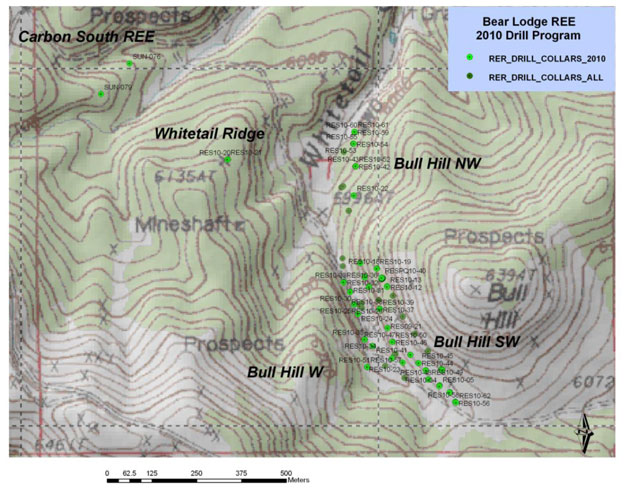
Figure 2. Bear Lodge Project-2010 drill hole locations.
The REE deposits in the Bear Lodge Mountains of northeastern Wyoming occur within a large alkaline igneous complex that domes overlying older sedimentary rocks. The deposits are spatially associated with several diatreme breccias that are distributed along a northwesterly alignment (Figure 3). The REE mineralization is hosted in intrusive dikes, veins, and stockwork bodies of carbonatite and its near-surface oxidized equivalents (FMR). FMR refers to the major constituents of the highly oxidized, former carbonatite dikes that occur in the depth range between the surface and 300-500 feet (91-152 meters) beneath the surface. These include iron oxides (F for FeOx), manganese oxides (M for MnOx), and rare earth minerals (R for REE minerals). Stockwork refers to a complex system of sub parallel to randomly oriented veins. The FMR bodies contain little or no groundmass calcite. A zone of variably oxidized carbonatite with minor to significant groundmass calcite and with zero to relatively minor unoxidized sulfide is termed transitional carbonatite. The transitional carbonatite exhibits significant variability with regard to proportions of groundmass calcite, iron and manganese oxides, and relict sulfide, and the Company is undertaking studies to further classify the unit and determine the sub-type or types most amenable to the current metallurgical flowsheet. The transition zone has uneven thickness and occurs beneath the FMR zone and above the deeper zone of unoxidized carbonatite. The mineralized bodies invade heterolithic intrusive breccia of the Bull Hill diatreme, as well as trachytic and phonolitic intrusive rocks.
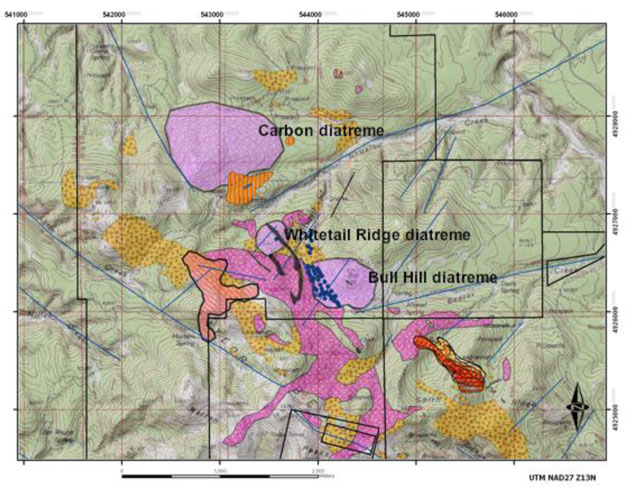
Figure 3. The diatreme breccias are distributed along a northwesterly alignment. The breccias are spatially associated with the REE-mineralized bodies
REE assay values are reported by convention as the combined oxide equivalents (REO) of the fifteen elements in the lanthanide series + yttrium. The oxide equivalents are approximately 15.6% higher than the combined metal assay values. The Bear Lodge project contains predominantly the "light" REE (lanthanum, cerium, praseodymium, and neodymium), and economically important quantities of several of the "heavy" REEs (europium, dysprosium, and terbium).
Significant assay results from the 2010 REE drilling program are given in Table 1.
Table 1. Significant drill results from the Rare Element Resources 2010 REE drilling program (intercepts >30 feet and >3.46% TREO).

Bull Hill Southwest Resource Area
Fifty core holes totaling 32,729 feet (9,978m) were drilled in the Bull Hill SW resource area in 2010 (Figure 2). Significant intercepts are summarized in Table 1. Most of the holes were drilled along a N45ºE azimuth, at 100 or 200 foot spacing from a series of sites along a N45ºE-trending resource evaluation grid established in conjunction with Ore Reserves Engineering, the Company's resource estimation consultant (Figures 2 and 4). Inclination angles were most commonly at -45º and -70º, or at minor deviations from those angles. Several of the holes were drilled on the same grid at an azimuth of S45ºW, again at inclination angles of at or near -45º and -70º. Drilling results confirm that the target FMR and carbonatite bodies exhibit strong REE mineralization over a strike length of more than 1400 feet (426m). Interpretive correlations of drill intercepts suggest a structural bias of the mineralized bodies toward vertical or near vertical dips.
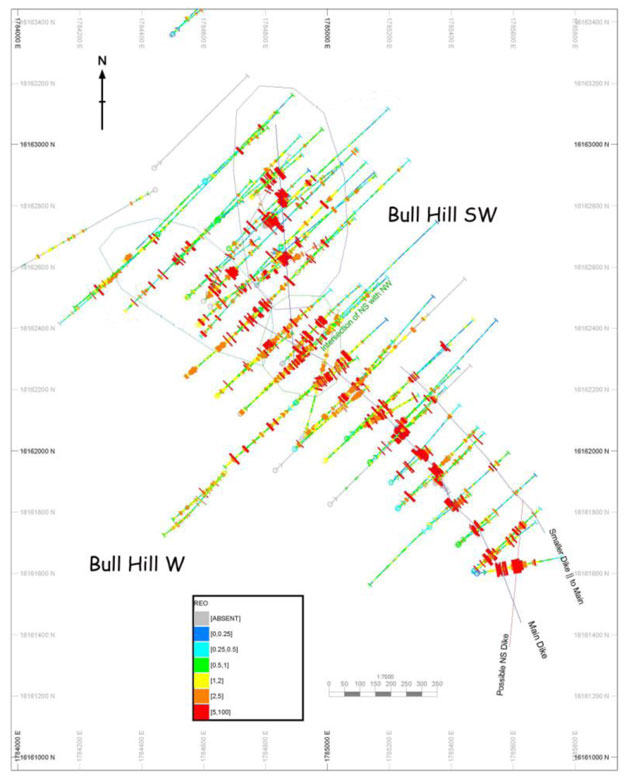
Figure 4. Plan view of drill hole traces and mineralized intercepts projected to the surface. Note the apparent transition from northwesterly to northerly strikes of the mineralized bodies in the northern third and at the southeastern margin of the Bull Hill SW resource area.
Geological interpretation of results from the 2011 drill program indicate that the Bull Hill SW resource area is dominated by northwest-striking mineralized bodies in the southern two-thirds of the resource area, while the northern part of the resource area exhibits a transitional change in strike from northwesterly to almost due north (Figure 4). The Bull Hill SW resource is open along strike to the southeast. The REE mineralization is contained within a main dike that can have a true width of up to about 119 feet (36m) and subordinate, sub parallel dikes and stockwork. There may be a second north-trending zone of mineralized dikes at the southeastern end of the current resource (Figure 4).
Bull Hill Northwest Resource Area
Nine core holes totaling 5,694 feet (1,736m) were drilled in the Bull Hill NW resource area in 2010 (Figure 2). Significant intercepts are listed in Table 1. REE mineralization in the Bull Hill NW resource area is contained within intrusive dikes, veins, and stockwork of FMR, transitional carbonatite/silicocarbonatite, and carbonatite/silicocarbonatite that invade trachytic and phonolitic intrusive rocks of the Bear Lodge alkaline complex. Silicocarbonatite is a carbonatite-related rock that carries abundant silicate mineral phases dispersed in the carbonate matrix. The silicate phases in the Bull Hill NW silicocarbonatite are primarily biotite and K feldspar. The structural controls for the mineralized bodies remain incompletely understood in this target area, but it appears most likely that northerly-striking mineralized bodies predominate. The north-striking mineralized bodies at Bull Hill NW appear generally to be narrower and lower-grade than those in the Bull Hill SW resource area, although exploration at Bull Hill NW has yet to be completed. Strongly anomalous gold mineralization in drill hole RES10-60 is distributed in trachyte porphyry and crosscutting biotite silicocarbonatite dikes, with the highest-grade intercept (12 ft @ 11.85gpt Au) contained within a biotite silicocarbonate dike. This occurrence of overlapping gold and REE mineralization, and another at the Whitetail Ridge target area, will be investigated during the Company's 2011 exploration program.
Two core holes totaling 1,631 feet (497m) were drilled at the Whitetail Ridge target in 2010 (Figure 2). Significant intercepts are given in Table 1. The Whitetail Ridge REE target area is located approximately 1,500 feet northwest of the Bull Hill Southwest deposit, adjacent to and west of the Bull Hill Northwest target. It is marked at the surface by a zone of FMR stockwork and a coincident geophysical anomaly. The size of the geophysical anomaly (approximately 1,400 by 2,000 feet elongate northeasterly) provides an indication that the REE target may be larger than others in the district. Historic hole WP-1, drilled within the Whitetail Ridge target area by Hecla Mining Company in 1987, intersected 430 feet that averaged 2.44% REO in a near-surface intercept from 0 to 430 feet (non-NI-43-101 compliant). Within the larger intercept were several 10-foot intercepts with grades ranging from 5.5 to 13.7% REO. The holes drilled during the 2010 program were sited based on detailed geological mapping (Figure 5), a ground geophysical survey, and historic drilling results from Duval, Molycorp, and Hecla. Detailed mapping suggests that the REE mineralization consists of northwest-striking FMR dikes and an FMR stockwork zone that is elongate northeasterly, with dimensions of roughly 1250 feet (380 meters) by 950 feet (290 meters). The enveloping geophysical anomaly is larger and may indicate a broader distribution of REE mineralization beneath the extensive soil and colluvial cover.
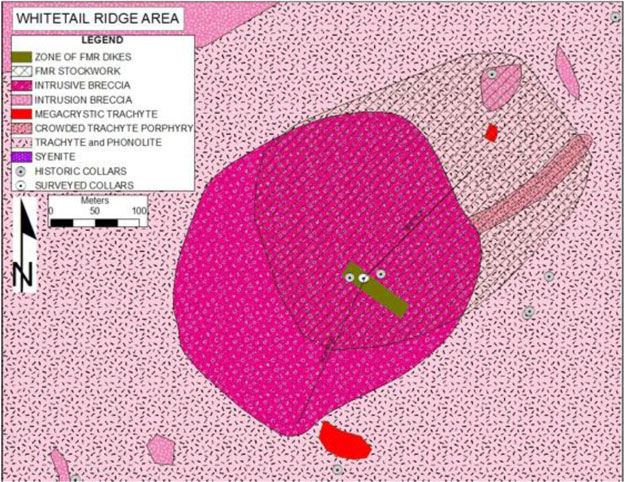
Figure 5. Geological map of part of the Whitetail Ridge REE target area. The zone of FMR dikes strikes northwesterly and cuts a diatreme breccia. The long axis of the FMR stockwork zone trends northeasterly.
Two core holes totaling 2,355 feet (718m) were collared in the Bull Hill West target area (Figure 2). Two other holes drilled in the Bull Hill SW resource area penetrated the Bull Hill West target area at depth. Significant assay results are given in Table 1. The results from drill holes RES10-46, RES10-47, RES10-51, and RES10-57 indicate that mineralized veins, dikes, and associated stockwork zones continue to the west across the Bull Hill drainage with little or no offset. The Company identifies this area west of the Bull Hill drainage as the Bull Hill West target (Figure 4), an area that combines target areas referred to in past news releases and presentations as the "Conceptual Carbonatite Plug" target and the "Fault Offset" target. Until these recent results from drilling west of the drainage, it was thought that the drainage represented a structure (West Bull Hill fault) that could have significantly offset or terminated the REE-mineralized dike swarms at the Bull Hill SW resource area.
Carbon South Gold / REE Target
Two reverse circulation drill holes (SUN-076 and SUN-079) completed during the Company's 2010 Sundance gold exploration program cut significant REE mineralization in FMR vein material that intrudes trachytic and syenitic intrusive rocks (Figure 2). The drill holes totaled 1,390 feet (424m) and were collared just south of the Carbon gold target and about 1,200 feet (366m) northwest of the Whitetail Ridge REE exploration target. The REE mineralization may portend the northwestern extension of the Whitetail Ridge system or, alternatively, a distinct FMR/carbonatite mineralized system. Significant REE-bearing intercepts from the Carbon South target area are given in Table 1. If this mineralization is a continuation of the Whitetail Ridge dike system and the Bull Hill SW system, its total length may reach up to 5000 feet (1500m) in length.
The drilling data were interpreted using LeapFrog 3D software, and the interpreted deposit geometry is illustrated in Figure 6.
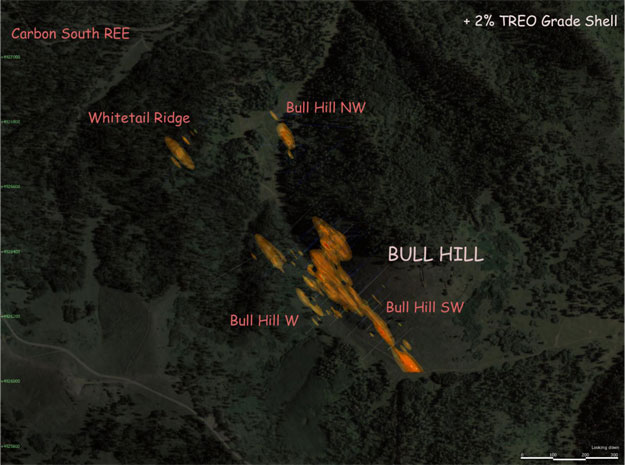
Figure 6. LeapFrog 3-D image of the Bull Hill and Whitetail Ridge REE deposits.
Bulk Sampling Program
The Company conducted a bulk sample collection program of FMR vein and stockwork material during September 2010. The objective of the program was the acquisition of about 8 tons or more of oxidized, REE-mineralized FMR vein material that will be used to feed a pilot plant designed to test the commercial viability of the mineral process flowsheet developed for the REE by Mountain States Research and Development, International (MSRDI), the Company's metallurgical testing consultants. The pilot plant testing is scheduled to commence during the third quarter of 2011. It is expected to produce a bulk mixed rare earth carbonate concentrate that can be used for marketing if the Company decides to sell concentrates initially, and as test material for the separation of individual rare earth oxides as a first step toward refinement and production of high purity rare earth oxide products. Several laboratories with pilot plant capabilities are under consideration for the testing. The pilot plant test will be part of a preliminary feasibility study planned for completion in late 2011.
The bulk testing program consisted of a series of large-diameter PQ (diameter 85mm) and HQ (diameter 63.5mm) core holes that penetrate the oxide zone in the Bull Hill Southwest REE deposit. The holes were drilled from closely spaced sites near the center and southeastern parts of the deposit, where the FMR vein material occurs very close to the surface. Drilling was designed to collect samples that would be representative of material sent to the mill during the first five years of potential production. The deepest holes were drilled to a depth of approximately 190 feet (58m). Grades are likely to range between 2% and 15% REO, based on previous exploration holes from the same sites. Multiple holes were drilled from each site in fans at a common azimuth and different inclination angles designed to capture as much FMR vein material as possible. A total of 40 holes was drilled, with an aggregate footage of 2117 feet (645 m) of REE-mineralized FMR material. Thirty of the drill holes are PQ-size holes for a total footage of 1753 feet (534 m) of FMR material, and ten of the holes are HQ-size, with a total footage of 364 feet (111 m) of FMR material. The aggregate weight of REE-mineralized material collected from the drilling program is about 12,700 pounds (5,773kg). Low-grade stockwork material collected during the drilling is currently undergoing metallurgical test work at Hazen Research of Golden, Colorado in order to examine methods of inexpensive upgrade of the REE values that take advantage of the physical characteristics of the FMR vein material.
The large diameter drill core samples are augmented by bulk sample material collected at and near the surface, where FMR vein material was identified during drill site construction. This material was collected in 55 gallon drums and has an aggregate weight of about 6750 pounds (3,068kg). Collectively, the Company has a total stockpile of about 9.7 tons (8.8 tonnes) of FMR material for use in the pilot plant test work. The material is stored currently at one of the Company's leased warehouses in Sundance, Wyoming. This material will be retained there until the testing laboratory is selected and the pilot plant is built and ready for operation. The program has acquired sufficient FMR feed material required for the pilot plant study.
Rare Element Resources Ltd (TSX-V: RES & AMEX: REE) is a publicly traded mineral resource company focused on exploration and development of rare-earth elements and gold on the Bear Lodge property.
Rare-earth elements are key components of the green energy technologies and other high-technology applications. Some of the major applications include hybrid automobiles, plug-in electric automobiles, advanced wind turbines, computer hard drives, compact fluorescent light bulbs, metal alloys, additives in ceramics and glass, petroleum cracking catalysts, and a number of critical military applications. China currently produces more than 95% of the 130,000 metric tonnes of rare-earths consumed annually worldwide, and China has been reducing its exports of rare earths each year. The rare-earth market is growing rapidly, and is projected to accelerate if the green technologies are implemented on a broad scale.
ON BEHALF OF THE BOARD
Donald E. Ranta, PhD, PGeo, President & CEO
For information, refer to the Company's website at www.rareelementresources.com or contact:
Mark T Brown, CFO, (604) 687-3520 ext 242 mtbrown@pacificopportunity.com .
Donald E Ranta, (604) 687-3520 don@rareelementresources.com
Donald E. Ranta, PhD, PGeo, serves the Board of Directors of the Company as an internal, technically Qualified Person. Technical information in this news release has been reviewed by Dr. Ranta and has been prepared in accordance with Canadian regulatory requirements that are set out in National Instrument 43-101. This news release was prepared by Company management, who take full responsibility for content. Neither TSX Venture Exchange nor its Regulation Services Provider (as that term is defined in the policies of the TSX Venture Exchange) accepts responsibility for the adequacy or accuracy of this release.
Forward Looking Statements
Except for statements of historical fact, certain information contained herein constitutes forward-looking statements. Forward looking statements are usually identified by our use of certain terminology, including "will", "believes", "may", "expects", "should", "seeks", "anticipates", "has potential to", or "intends' or by discussions of strategy or intentions. Such forward-looking statements involve known and unknown risks, uncertainties and other factors which may cause our actual results or achievements to be materially different from any future results or achievements expressed or implied by such forward-looking statements. Forward-looking statements are statements that are not historical facts, and include but are not limited to, estimates and their underlying assumptions; statements regarding plans, objectives and expectations with respect to the effectiveness of the Company's business model; future operations, products and services; the impact of regulatory initiatives on the Company's operations; the size of and opportunities related to the market for the Company's products; general industry and macroeconomic growth rates; expectations related to possible joint and/or strategic ventures and statements regarding future performance.
Forward-looking statements used in this discussion are subject to various risks and uncertainties, most of which are difficult to predict and generally beyond the control of the Company. If risks or uncertainties materialize, or if underlying assumptions prove incorrect, our actual results may vary materially from those expected, estimated or projected. Forward-looking statements in this document are not a prediction of future events or circumstances, and those future events or circumstances may not occur. Given these uncertainties, users of the information included herein, including investors and prospective investors are cautioned not to place undue reliance on such forward-looking statements.